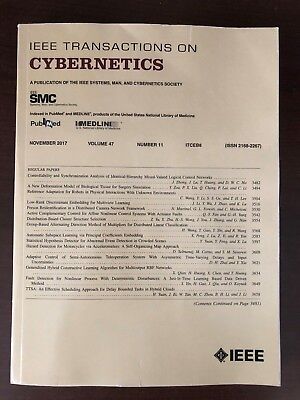非齐次暂居概率二维模糊切换系统的观测器安全控制
IF 10.5
1区 计算机科学
Q1 AUTOMATION & CONTROL SYSTEMS
引用次数: 0
摘要
提出了一种新的二维域非齐次逗留概率框架,研究了基于自适应阈值饱和函数的二维模糊切换系统的观测器安全控制问题。与现有的齐次/非齐次马尔可夫过程相比,本文提出的非齐次逗留概率框架增强了可测量性,降低了计算复杂度,是一种更为合理的方法。二维模糊SS的安全控制挑战是在具有不确定发生率的随机发生攻击的背景下解决的,其中不确定性在标称率周围是规范有界和不对称的。为了减轻这些异常攻击的影响,采用了一种新的基于自适应阈值的饱和函数,确保传输的信息保持在可接受的范围内。利用李雅普诺夫理论,得到了保证渐近均方稳定并具有噪声衰减性能的充分条件。通过仿真算例验证了理论结果的有效性。本文章由计算机程序翻译,如有差异,请以英文原文为准。
Observer-Based Security Control for 2-D Fuzzy Switched Systems With Nonhomogeneous Sojourn Probabilities
This article proposes a novel framework of nonhomogeneous sojourn probabilities in the 2-D domain and investigates the observer-based security control issue for 2-D fuzzy switched systems (SS) under an adaptive-threshold-based saturation function. In comparison with the existing homogeneous/nonhomogeneous Markov processes, the proposed nonhomogeneous sojourn probability framework enhances measurability and reduces computational complexity, making it a more reasonable approach. The security control challenge for 2-D fuzzy SS is addressed in the context of randomly occurring attacks with uncertain occurrence rates, where the uncertainty is norm-bounded and asymmetrical around the nominal rate. To mitigate the effects of these abnormal attacks, a novel adaptive-threshold-based saturation function is employed, ensuring that transmitted information remains within an acceptable range. Leveraging Lyapunov theories, sufficient conditions are attained to guarantee the asymptotically mean square stable with noise attenuation performance. The validity of the proposed theoretical results is demonstrated through a simulation example.
求助全文
通过发布文献求助,成功后即可免费获取论文全文。
去求助
来源期刊

IEEE Transactions on Cybernetics
COMPUTER SCIENCE, ARTIFICIAL INTELLIGENCE-COMPUTER SCIENCE, CYBERNETICS
CiteScore
25.40
自引率
11.00%
发文量
1869
期刊介绍:
The scope of the IEEE Transactions on Cybernetics includes computational approaches to the field of cybernetics. Specifically, the transactions welcomes papers on communication and control across machines or machine, human, and organizations. The scope includes such areas as computational intelligence, computer vision, neural networks, genetic algorithms, machine learning, fuzzy systems, cognitive systems, decision making, and robotics, to the extent that they contribute to the theme of cybernetics or demonstrate an application of cybernetics principles.
 求助内容:
求助内容: 应助结果提醒方式:
应助结果提醒方式:


